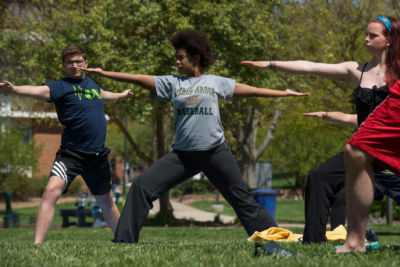By: Wilson Hurley, LCSW, Adjunct Professor in Mason’s Social Work Department, Clinical Social Worker in private practice, and author of the book Compassion’s COMPASS: Strategies for Developing Kindness and Insight
“Equanimity is calamity’s medicine.” – Publilius Syrus
Research psychologists have begun to focus on the benefits of equanimity, a form of mental stability that can be enhanced through mindfulness practice. It is an evenness of mind that is unruffled by the vicissitudes of life. Pursuing equanimity can significantly help us relieve stress.
Equanimity has been recommended as an aid to mood regulation by Farb, Anderson, and Segal (2012), who define equanimity as “the suspension of judging experience to be intrinsically good or bad.” In Buddhism, equanimity has various definitions. When practiced as an antidote to emotional reactivity, it can be defined as “the mind resting naturally, free from attachment, anger, and delusion. Its function is to avoid giving occasion for the disturbing emotions.”
Researchers have found that equanimity supports emotional regulation and enhances mental health and wellbeing. It helps us tolerate unpleasant sensations and to disengage from the ups and downs of emotional pulls. In a way, it can be seen as a byproduct of exposure. Our feelings get used to a variety of experiences when we persevere with, rather than avoid, things that challenge us.
Mindfulness Practices for Equanimity
Practicing mindfulness regularly can aid us in this process. Spending time each day sitting mindfully helps us maintain awareness of mental and physical sensations, which constitutes a mild form of exposure. One easy way to practice this is through the four foundations of mindfulness:
1. Mindfulness of body:
- Begin by noticing your breath as it leaves your nostrils and returns, noticing if it’s a short breath or a long breath.
- Be aware of your whole body as you breathe.
- Breathe in calm and breathe out stress.
- Let your body start to calm and settle.
2. Mindfulness of feelings:
- As you notice your breath, also notice your feelings.
- Be aware of the present moment as you breathe.
- Breathe in joy and breathe out sorrow.
- Let your feelings start to settle.
3. Mindfulness of awareness:
- As you notice your breath, also notice your awareness.
- Focus your awareness on the present moment.
- Notice the clear nature of your awareness, freeing it from worries.
- Concentrate your awareness on your breath.
4. Mindfulness of mental objects:
- As you focus on your breath, notice thoughts come and go.
- Notice the changing and impermanent nature of thoughts.
- Let disturbing thoughts and feelings fade away.
- Let go of thoughts and return your focus to your breath.
There is also research emerging showing equanimity as a support for compassion development. It can help us remove bias, which otherwise might limit the scope of our empathy and compassion. This aspect of equanimity has led to other definitions. Joey Weber of the University of Bolton recommends expanding the definition of equanimity to include an inner and outer form. He suggests that a possible definition for inner equanimity could be an “open acceptance of non-reactivity towards your discrimination faculties (pleasure, displeasure, neutrality), so you can respond with compassion for self and others.” His definition for external equanimity is “accepting an individual’s discrimination faculties (pleasure, displeasure, neutrality), so to forgive and respond with compassion for self and others.” This aspect of equanimity can be cultivated by bringing to mind three people in your life:
- Someone towards whom you have neutral feelings.
- Someone towards whom you have positive feelings.
- Someone you dislike.
Pay attention to how your feelings change as you consider your relationship to each person. Then imagine how your feelings towards the neutral person would change if they did something negative or positive towards you. How would your feelings change towards the positive person if they started harming you and saying negative things about you? How would your feelings change towards the person you dislike if they apologized sincerely for past wrongs and began treating you in a consistently supportive way? We can see how over the course of our lifetime strangers can become important to us, friends can become strangers, and enemies can become friends.
In the COMPASS (Compassion and Analytical Selective-Focus Skills) approach to compassion development, equanimity is defined as “an unbiased mind focused on our shared humanity and everyone’s equal wish to find happiness and avoid suffering.” While humanity has much diversity as to culture, race, gender, religious belief and so on, we all are equal in our wish to find happiness, love, and security and to avoid suffering, harm, and rejection. We can cultivate a universal form of equanimity by deeply considering this aspect of our common humanity. One way to practice this form of equanimity is to contemplate the following points:
- We are all equal in wanting to be happy and in wanting to avoid suffering.
- Just like I want to be loved, valued, and respected; everyone wants to be loved, valued, and respected.
- If people treated each other with equal friendship and respect, it would reduce conflict and strife. The world would be a happier and more peaceful place.
- Think: “How wonderful it would be if everyone abided in equanimity. In order to make my own mind more peaceful, and in order to help reduce conflicts, I will try to develop an equal sense of friendliness for everyone.” Hold this thought for a while.
Additional Resources
Audio: Meditation on Equanimity by Jack Kornfield, https://jackkornfield.com/meditation-equanimity/
Video: Kristen Neff: Compassion with Equanimity Practice for Caregivers, https://youtu.be/EHvX7_ib-F0
Article: Practicing Equanimity in a State of Emergency, by Gary Cach, https://www.lionsroar.com/practicing-equanimity-in-a-state-of-emergency/
Write one of these Thriving Together Series features! We’re looking for contributions on all topics related to well-being. Read other Thriving Together Series articles here and contact us at [email protected] for guidelines. Thank you for helping our Mason community thrive together online!





















